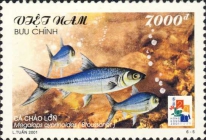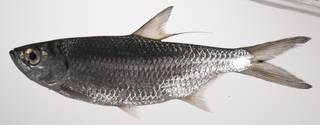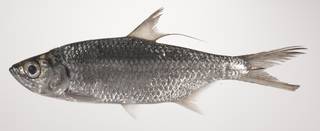WoRMS taxon details
Megalops cyprinoides (Broussonet, 1782)
212253 (urn:lsid:marinespecies.org:taxname:212253)
accepted
Species
Brisbania staigeri Castelnau, 1878 · unaccepted
Clupea cyprinoides Broussonet, 1782 · unaccepted
Clupea gigantea Shaw, 1804 · unaccepted (synonym)
Clupea thrissoides Bloch & Schneider, 1801 · unaccepted
Cyprinodon cundinga Hamilton, 1822 · unaccepted
Elops cundinga (Hamilton, 1822) · unaccepted
Elops cyprinoides (Broussonet, 1782) · unaccepted
Magalops cyprinoides (Broussonet, 1782) · unaccepted (misspelling)
Megalops cundinga (Hamilton, 1822) · unaccepted
Megalops curtifilis Richardson, 1846 · unaccepted
Megalops cyoprinoides (Broussonet, 1782) · unaccepted (misspelling)
Megalops filamentosus Lacepède, 1803 · unaccepted
Megalops giganteus (Shaw, 1804) · unaccepted
Megalops indicus Valenciennes, 1847 · unaccepted
Megalops kundinga Bleeker, 1866 · unaccepted (synonym)
Megalops macrophthalmus Bleeker, 1851 · unaccepted
Megalops macropterus Bleeker, 1866 · unaccepted
Megalops oligolepis Bleeker, 1866 · unaccepted
Megalops setipinnis Richardson, 1843 · unaccepted
marine, brackish, fresh, terrestrial
(of Clupea cyprinoides Broussonet, 1782) Broussonet, P. M. A. (1782). Ichthyologia, sistens piscium descriptiones et icones. <em>Decas I. London.</em> unnum. pages, incl. i-iv., Unnum. Pls. 1-11.
page(s): [39], Pl. [9] [details]
page(s): [39], Pl. [9] [details]
Description Adults are generally only found at sea, but the young inhabits river mouths, inner bays, and mangrove forests. Occurs at...
Description Adults are generally only found at sea, but the young inhabits river mouths, inner bays, and mangrove forests. Occurs at temperatures ranging from 28 to 32°C, and salinities from 0 to 100. Mainly diurnal (Ref. 7017). Predaceous, feeding mainly on fish and crustaceans (Refs. 5213; 10982). Breeds offshore in the sea, possibly throughout the year. Known to breath air, rising regularly to the surface to do so. The swimbladder is modified for this purpose (Ref. 7248 and 9710). Cultured in ponds, the fry being sourced from the coasts (Ref. 7050). Utilized fresh and also for its roe (Ref. 9987) <111> Widely distributed in the Inian and Pacific oceans: India, Ceylon, East Indies, Philippines, China, Japan, Formosa, Australia, Melanesia, Micronesia and Polynesia <360> [details]
Froese, R. and D. Pauly. Editors. (2024). FishBase. Megalops cyprinoides (Broussonet, 1782). Accessed through: World Register of Marine Species at: https://www.marinespecies.org/aphia.php?p=taxdetails&id=212253 on 2024-07-26
Date
action
by
![]() The webpage text is licensed under a Creative Commons Attribution-Noncommercial 4.0 License
The webpage text is licensed under a Creative Commons Attribution-Noncommercial 4.0 License
original description
(of Megalops filamentosus Lacepède, 1803) Lacepède, B.G.E. (1803). Histoire naturelle des poissons. Tome Cinquieme. 5(1-21): i-lxviii + 1-803 + index., available online at https://www.biodiversitylibrary.org/page/6335629 [details]
original description (of Clupea cyprinoides Broussonet, 1782) Broussonet, P. M. A. (1782). Ichthyologia, sistens piscium descriptiones et icones. <em>Decas I. London.</em> unnum. pages, incl. i-iv., Unnum. Pls. 1-11.
page(s): [39], Pl. [9] [details]
original description (of Clupea gigantea Shaw, 1804) Shaw, G. (1804). General zoology or systematic natural history . [see Shaw 1803, ref. 4014]. v. 5 (pt 1): i-v + 1-250, Pls. 93-132, and (pt 2): i-vi + 251-463, Pls. 132-182.
page(s): 173 [details]
original description (of Clupea thrissoides Bloch & Schneider, 1801) Bloch, M.E.; Schneider, J.G. (1801). M.E. Blochii, Systema Ichthyologiae iconibus cx illustratum. Post obitum auctoris opus inchoatum absolvit, correxit, interpolavit Jo. <em>Gottlob Schneider, Saxo. Berolini. Sumtibus Auctoris Impressum et Bibliopolio Sanderiano Commissum.</em> Pp i-lx + 1-584, Pls. 1-110., available online at https://www.biodiversitylibrary.org/bibliography/5750#/summary
page(s): 424 [details]
original description (of Megalops macrophthalmus Bleeker, 1851) Bleeker, P. (1851). Over eenige nieuwe soorten van Megalops, Dussumieria, Notopterus en Astronesthes. <em>Natuurkundig Tijdschrift voor Nederlandsch Indië.</em> v. 1 (no. 4): 417-424. [details]
original description (of Megalops macropterus Bleeker, 1866) Bleeker, P. (1866). Sur la pluralité des espèces Indo-archipélagiques du genre Megalops Lac. <em>Nederlandsch Tijdschrift voor de Dierkunde.</em> v. 3: 278-292.
page(s): 284 [details]
original description (of Megalops oligolepis Bleeker, 1866) Bleeker, P. (1866). Sur la pluralité des espèces Indo-archipélagiques du genre Megalops Lac. <em>Nederlandsch Tijdschrift voor de Dierkunde.</em> v. 3: 278-292.
page(s): 292 [details]
original description (of Brisbania staigeri Castelnau, 1878) Castelnau, F. L. (1878). Australian fishes. New or little known species. <em>Proceedings of the Linnean Society of New South Wales.</em> v. 2 (pt 3): 225-248, Pls. 2-3.
page(s): 241, Pl. 3 [details]
original description (of Cyprinodon cundinga Hamilton, 1822) Hamilton, F. [Buchanan] (1822). An account of the fishes found in the river Ganges and its branches. Edinburgh & London. Pp i-vii + 1-405, Pls. 1-39.
page(s): 254, 283 [details]
original description (of Megalops kundinga Bleeker, 1866) Bleeker, P. (1866). Sur la pluralité des espèces Indo-archipélagiques du genre Megalops Lac. <em>Nederlandsch Tijdschrift voor de Dierkunde.</em> v. 3: 278-292.
page(s): 288 [details]
context source (HKRMS) Hong Kong marine fish database. <em>AFCD.</em> , available online at https://www.hk-fish.net/en/fish/introduction/ [details]
context source (RAS) Australian Antarctic Data Centre. , available online at https://data.aad.gov.au/aadc/biodiversity/ [details]
basis of record Froese, R. & D. Pauly (Editors). (2023). FishBase. World Wide Web electronic publication. version (02/2023)., available online at https://www.fishbase.org [details]
additional source Liu, J.Y. [Ruiyu] (ed.). (2008). Checklist of marine biota of China seas. <em>China Science Press.</em> 1267 pp. (look up in IMIS) [details] Available for editors [request]
[request]
ecology source Looby, A.; Erbe, C.; Bravo, S.; Cox, K.; Davies, H. L.; Di Iorio, L.; Jézéquel, Y.; Juanes, F.; Martin, C. W.; Mooney, T. A.; Radford, C.; Reynolds, L. K.; Rice, A. N.; Riera, A.; Rountree, R.; Spriel, B.; Stanley, J.; Vela, S.; Parsons, M. J. G. (2023). Global inventory of species categorized by known underwater sonifery. <em>Scientific Data.</em> 10(1). (look up in IMIS), available online at https://doi.org/10.1038/s41597-023-02745-4 [details]
original description (of Clupea cyprinoides Broussonet, 1782) Broussonet, P. M. A. (1782). Ichthyologia, sistens piscium descriptiones et icones. <em>Decas I. London.</em> unnum. pages, incl. i-iv., Unnum. Pls. 1-11.
page(s): [39], Pl. [9] [details]
original description (of Clupea gigantea Shaw, 1804) Shaw, G. (1804). General zoology or systematic natural history . [see Shaw 1803, ref. 4014]. v. 5 (pt 1): i-v + 1-250, Pls. 93-132, and (pt 2): i-vi + 251-463, Pls. 132-182.
page(s): 173 [details]
original description (of Clupea thrissoides Bloch & Schneider, 1801) Bloch, M.E.; Schneider, J.G. (1801). M.E. Blochii, Systema Ichthyologiae iconibus cx illustratum. Post obitum auctoris opus inchoatum absolvit, correxit, interpolavit Jo. <em>Gottlob Schneider, Saxo. Berolini. Sumtibus Auctoris Impressum et Bibliopolio Sanderiano Commissum.</em> Pp i-lx + 1-584, Pls. 1-110., available online at https://www.biodiversitylibrary.org/bibliography/5750#/summary
page(s): 424 [details]
original description (of Megalops macrophthalmus Bleeker, 1851) Bleeker, P. (1851). Over eenige nieuwe soorten van Megalops, Dussumieria, Notopterus en Astronesthes. <em>Natuurkundig Tijdschrift voor Nederlandsch Indië.</em> v. 1 (no. 4): 417-424. [details]
original description (of Megalops macropterus Bleeker, 1866) Bleeker, P. (1866). Sur la pluralité des espèces Indo-archipélagiques du genre Megalops Lac. <em>Nederlandsch Tijdschrift voor de Dierkunde.</em> v. 3: 278-292.
page(s): 284 [details]
original description (of Megalops oligolepis Bleeker, 1866) Bleeker, P. (1866). Sur la pluralité des espèces Indo-archipélagiques du genre Megalops Lac. <em>Nederlandsch Tijdschrift voor de Dierkunde.</em> v. 3: 278-292.
page(s): 292 [details]
original description (of Brisbania staigeri Castelnau, 1878) Castelnau, F. L. (1878). Australian fishes. New or little known species. <em>Proceedings of the Linnean Society of New South Wales.</em> v. 2 (pt 3): 225-248, Pls. 2-3.
page(s): 241, Pl. 3 [details]
original description (of Cyprinodon cundinga Hamilton, 1822) Hamilton, F. [Buchanan] (1822). An account of the fishes found in the river Ganges and its branches. Edinburgh & London. Pp i-vii + 1-405, Pls. 1-39.
page(s): 254, 283 [details]
original description (of Megalops kundinga Bleeker, 1866) Bleeker, P. (1866). Sur la pluralité des espèces Indo-archipélagiques du genre Megalops Lac. <em>Nederlandsch Tijdschrift voor de Dierkunde.</em> v. 3: 278-292.
page(s): 288 [details]
context source (HKRMS) Hong Kong marine fish database. <em>AFCD.</em> , available online at https://www.hk-fish.net/en/fish/introduction/ [details]
context source (RAS) Australian Antarctic Data Centre. , available online at https://data.aad.gov.au/aadc/biodiversity/ [details]
basis of record Froese, R. & D. Pauly (Editors). (2023). FishBase. World Wide Web electronic publication. version (02/2023)., available online at https://www.fishbase.org [details]
additional source Liu, J.Y. [Ruiyu] (ed.). (2008). Checklist of marine biota of China seas. <em>China Science Press.</em> 1267 pp. (look up in IMIS) [details] Available for editors
ecology source Looby, A.; Erbe, C.; Bravo, S.; Cox, K.; Davies, H. L.; Di Iorio, L.; Jézéquel, Y.; Juanes, F.; Martin, C. W.; Mooney, T. A.; Radford, C.; Reynolds, L. K.; Rice, A. N.; Riera, A.; Rountree, R.; Spriel, B.; Stanley, J.; Vela, S.; Parsons, M. J. G. (2023). Global inventory of species categorized by known underwater sonifery. <em>Scientific Data.</em> 10(1). (look up in IMIS), available online at https://doi.org/10.1038/s41597-023-02745-4 [details]
 Present
Present  Present in aphia/obis/gbif/idigbio
Present in aphia/obis/gbif/idigbio  Inaccurate
Inaccurate  Introduced: alien
Introduced: alien  Containing type locality
Containing type locality
From other sources
Description Adults are generally only found at sea, but the young inhabits river mouths, inner bays, and mangrove forests. Occurs at temperatures ranging from 28 to 32°C, and salinities from 0 to 100. Mainly diurnal (Ref. 7017). Predaceous, feeding mainly on fish and crustaceans (Refs. 5213; 10982). Breeds offshore in the sea, possibly throughout the year. Known to breath air, rising regularly to the surface to do so. The swimbladder is modified for this purpose (Ref. 7248 and 9710). Cultured in ponds, the fry being sourced from the coasts (Ref. 7050). Utilized fresh and also for its roe (Ref. 9987) <111> Widely distributed in the Inian and Pacific oceans: India, Ceylon, East Indies, Philippines, China, Japan, Formosa, Australia, Melanesia, Micronesia and Polynesia <360> [details]
To Barcode of Life (82 barcodes)
To Biodiversity Heritage Library (12 publications) (from synonym Elops cyprinoides (Broussonet, 1782))
To Biodiversity Heritage Library (13 publications) (from synonym Elops cundinga (Hamilton, 1822))
To Biodiversity Heritage Library (179 publications)
To Biodiversity Heritage Library (18 publications) (from synonym Clupea thrissoides Bloch & Schneider, 1801)
To Biodiversity Heritage Library (18 publications) (from synonym Megalops macropterus Bleeker, 1866)
To Biodiversity Heritage Library (19 publications) (from synonym Cyprinodon cundinga Hamilton, 1822)
To Biodiversity Heritage Library (23 publications) (from synonym Megalops setipinnis Richardson, 1843)
To Biodiversity Heritage Library (31 publications) (from synonym Clupea gigantea Shaw, 1804)
To Biodiversity Heritage Library (32 publications) (from synonym Megalops filamentosus Lacepède, 1803)
To Biodiversity Heritage Library (4 publications) (from synonym Megalops cundinga (Hamilton, 1822))
To Biodiversity Heritage Library (55 publications) (from synonym Megalops indicus Valenciennes, 1847)
To Biodiversity Heritage Library (6 publications) (from synonym Megalops oligolepis Bleeker, 1866)
To Biodiversity Heritage Library (6 publications) (from synonym Brisbania staigeri Castelnau, 1878)
To Biodiversity Heritage Library (77 publications) (from synonym Clupea cyprinoides Broussonet, 1782)
To Biodiversity Heritage Library (8 publications) (from synonym Megalops giganteus (Shaw, 1804))
To Biodiversity Heritage Library (8 publications) (from synonym Megalops curtifilis Richardson, 1846)
To Biodiversity Heritage Library (9 publications) (from synonym Megalops macrophthalmus Bleeker, 1851)
To Biological Information System for Marine Life (BISMaL)
To European Nucleotide Archive, ENA (Megalops cundinga) (from synonym Megalops cundinga (Hamilton, 1822))
To European Nucleotide Archive, ENA (Megalops cyprinoides)
To FishBase (from synonym Megalops filamentosus Lacepède, 1803)
To FishBase (from synonym Clupea cyprinoides Broussonet, 1782)
To FishBase (from synonym Clupea thrissoides Bloch & Schneider, 1801)
To FishBase
To FishBase (from synonym Megalops curtifilis Richardson, 1846)
To FishBase (from synonym Megalops giganteus (Shaw, 1804))
To FishBase (from synonym Megalops cundinga (Hamilton, 1822))
To FishBase (from synonym Megalops macropterus Bleeker, 1866)
To FishBase (from synonym Megalops oligolepis Bleeker, 1866)
To FishBase (from synonym Megalops indicus Valenciennes, 1847)
To FishBase (from synonym Megalops macrophthalmus Bleeker, 1851)
To FishBase (from synonym Magalops cyprinoides (Broussonet, 1782))
To FishBase (from synonym Megalops cyoprinoides (Broussonet, 1782))
To FishBase (from synonym Megalops kundinga Bleeker, 1866)
To FishBase (from synonym Cyprinodon cundinga Hamilton, 1822)
To FishBase (from synonym Megalops setipinnis Richardson, 1843)
To FishBase (from synonym Elops cyprinoides (Broussonet, 1782))
To FishBase (from synonym Clupea gigantea Shaw, 1804)
To FishBase (from synonym Elops cundinga (Hamilton, 1822))
To FishBase (from synonym Brisbania staigeri Castelnau, 1878)
To FishBase images (Megalops cyprinoides, Sri Lanka, by Ramani Shirantha)
To GenBank (2 nucleotides; 2 proteins) (from synonym Megalops cundinga (Hamilton, 1822))
To GenBank (2 nucleotides; 2 proteins) (from synonym Cyprinodon cundinga Hamilton, 1822)
To GenBank (46472 nucleotides; 40236 proteins)
To GenBank (46472 nucleotides; 40236 proteins) (from synonym Clupea cyprinoides Broussonet, 1782)
To Global Biotic Interactions (GloBI)
To IUCN Red List (Data Deficient)
To NHMUK collection (Megalops setipinnis Richardson, 1843; SYNTYPE; NHMUK:ecatalogue:2528995) (from synonym Megalops setipinnis Richardson, 1843)
To NMNH Extant Collection (Megalops cyprinoides USNM 435526 photograph lateral view)
To NMNH Extant Collection (Megalops cyprinoides USNM 435532 photograph lateral view)
To ITIS
To Biodiversity Heritage Library (12 publications) (from synonym Elops cyprinoides (Broussonet, 1782))
To Biodiversity Heritage Library (13 publications) (from synonym Elops cundinga (Hamilton, 1822))
To Biodiversity Heritage Library (179 publications)
To Biodiversity Heritage Library (18 publications) (from synonym Clupea thrissoides Bloch & Schneider, 1801)
To Biodiversity Heritage Library (18 publications) (from synonym Megalops macropterus Bleeker, 1866)
To Biodiversity Heritage Library (19 publications) (from synonym Cyprinodon cundinga Hamilton, 1822)
To Biodiversity Heritage Library (23 publications) (from synonym Megalops setipinnis Richardson, 1843)
To Biodiversity Heritage Library (31 publications) (from synonym Clupea gigantea Shaw, 1804)
To Biodiversity Heritage Library (32 publications) (from synonym Megalops filamentosus Lacepède, 1803)
To Biodiversity Heritage Library (4 publications) (from synonym Megalops cundinga (Hamilton, 1822))
To Biodiversity Heritage Library (55 publications) (from synonym Megalops indicus Valenciennes, 1847)
To Biodiversity Heritage Library (6 publications) (from synonym Megalops oligolepis Bleeker, 1866)
To Biodiversity Heritage Library (6 publications) (from synonym Brisbania staigeri Castelnau, 1878)
To Biodiversity Heritage Library (77 publications) (from synonym Clupea cyprinoides Broussonet, 1782)
To Biodiversity Heritage Library (8 publications) (from synonym Megalops giganteus (Shaw, 1804))
To Biodiversity Heritage Library (8 publications) (from synonym Megalops curtifilis Richardson, 1846)
To Biodiversity Heritage Library (9 publications) (from synonym Megalops macrophthalmus Bleeker, 1851)
To Biological Information System for Marine Life (BISMaL)
To European Nucleotide Archive, ENA (Megalops cundinga) (from synonym Megalops cundinga (Hamilton, 1822))
To European Nucleotide Archive, ENA (Megalops cyprinoides)
To FishBase (from synonym Megalops filamentosus Lacepède, 1803)
To FishBase (from synonym Clupea cyprinoides Broussonet, 1782)
To FishBase (from synonym Clupea thrissoides Bloch & Schneider, 1801)
To FishBase
To FishBase (from synonym Megalops curtifilis Richardson, 1846)
To FishBase (from synonym Megalops giganteus (Shaw, 1804))
To FishBase (from synonym Megalops cundinga (Hamilton, 1822))
To FishBase (from synonym Megalops macropterus Bleeker, 1866)
To FishBase (from synonym Megalops oligolepis Bleeker, 1866)
To FishBase (from synonym Megalops indicus Valenciennes, 1847)
To FishBase (from synonym Megalops macrophthalmus Bleeker, 1851)
To FishBase (from synonym Magalops cyprinoides (Broussonet, 1782))
To FishBase (from synonym Megalops cyoprinoides (Broussonet, 1782))
To FishBase (from synonym Megalops kundinga Bleeker, 1866)
To FishBase (from synonym Cyprinodon cundinga Hamilton, 1822)
To FishBase (from synonym Megalops setipinnis Richardson, 1843)
To FishBase (from synonym Elops cyprinoides (Broussonet, 1782))
To FishBase (from synonym Clupea gigantea Shaw, 1804)
To FishBase (from synonym Elops cundinga (Hamilton, 1822))
To FishBase (from synonym Brisbania staigeri Castelnau, 1878)
To FishBase images (Megalops cyprinoides, Sri Lanka, by Ramani Shirantha)
To GenBank (2 nucleotides; 2 proteins) (from synonym Megalops cundinga (Hamilton, 1822))
To GenBank (2 nucleotides; 2 proteins) (from synonym Cyprinodon cundinga Hamilton, 1822)
To GenBank (46472 nucleotides; 40236 proteins)
To GenBank (46472 nucleotides; 40236 proteins) (from synonym Clupea cyprinoides Broussonet, 1782)
To Global Biotic Interactions (GloBI)
To IUCN Red List (Data Deficient)
To NHMUK collection (Megalops setipinnis Richardson, 1843; SYNTYPE; NHMUK:ecatalogue:2528995) (from synonym Megalops setipinnis Richardson, 1843)
To NMNH Extant Collection (Megalops cyprinoides USNM 435526 photograph lateral view)
To NMNH Extant Collection (Megalops cyprinoides USNM 435532 photograph lateral view)
To ITIS





